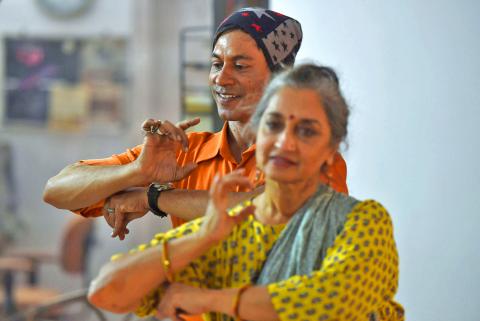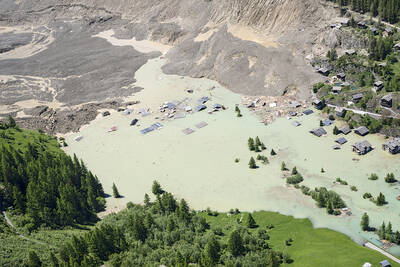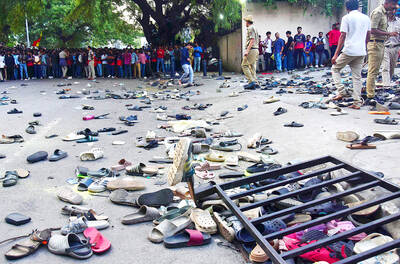With her arms stretched out and her hands elegantly curved, the young dancer stamps her feet with aplomb, defying prejudice.
Her art is reviled by many in religiously conservative Pakistan, where it is often linked with prostitution.
“We constantly have to explain to people that dance is an art form, it’s not just about what happens in the red light areas, not just about entertaining men and sexuality,” Suhaee Abro says.

Photo: AFP
Graceful and poised in her richly colored sari, she practices the odissi form of dance, in which movements of the face and hands are perfectly timed.
Dance is deeply embedded in Pakistani culture, in marriages, folk festivals and films — the complex choreography similar to that found in Bollywood. However, it is also deeply frowned upon for women to be seen dancing outside of a family setting, and worse still to perform for money.
“Unfortunately it is associated with the ‘dancing girls of Lahore,’” says Rahat Kazmi from Pakistan’s National Academy for Performing Arts — a reference to prostitutes swaying awkwardly in the red light district of the cultural capital.
Historically, classical dance in the subcontinent was the domain of tawaifs, courtesans of the Mughal Empire, which ruled India for hundreds of years until the advent of British rule in the 19th century.
Like the geishas of Japan, they were known as connoisseurs of the fine arts before their status deteriorated, especially under British rule, to mere prostitutes.
Today, prostitutes sometimes use dancing as a cover to carry out their illegal trade.
It is therefore necessary “to create this bifurcation and say that no, this is art also,” Kazmi says.
“I am a practicing Muslim and a dancer, and I don’t see why this should clash. My heart does not feel anything wrong,” says anthropologist and professional dancer Feriyal Aslam, who practices bharatanatyam, a form from southern India.
“But my mom herself feels it is wrong. She thinks ‘what will I say to God one day, that I did not tell my daughter to do the right thing,’” says the 40-year-old, who has also written a thesis on the subject.
Dance was banned in 1981 as part of an Islamization drive led by military ruler Zia-ul-Haq. His directive specifically targeted dancers wearing ankle bells, an essential accessory of the main classical forms, which the regime associated with obscenity and nudity.
The directive exists to this day, but its application has eased, though new threats have emerged.
“Now the bureaucratic hassle is not so strong, but the Taliban mindset had gotten into the mind of the people,” dancer Sheema Kirmani says.
Anyone in the audience “who feels that he might get to heaven by killing you can just walk up to the stage and do so,” she says.
What is more, dance enjoys no institutional support, with dancers often forced by economy to work second jobs, and both the private and public sectors reluctant to be associated with the art.
That reluctance is amplified by Pakistani classical dance’s shared lineage with India.
Pakistan has been desperate to distinguish itself from its neighbor and arch-rival since the partition of the subcontinent in 1947, but odissi and bharatanatyam are historically linked to Hinduism, and many Pakistani dancers complete their training in India due to the lack of facilities back home.
“[By] creating an identity which had nothing to do with our Indian past, we gave up on dance, music, theater,” says Kirmani, known as a “guru” in her own right. “But what identity can Pakistan create in just a few years, if it denigrates all common past?”
“There is no Hindu or Muslim dance, dance is dance,” says Suhaee Abro, a former student of Kirmani.
One form that has gained a sort of official recognition is kathak, with its dazzling and noisy footwork akin to flamenco, and dancers whirling like dervishes. This indulgence derives from the fact that it was practiced in the Muslim court of the Mughals.
To rehabilitate dance’s image, “people need to be exposed to good proper classical dance,” says Adnan Jihangir, a rare example of a male kathak dancer, whose own parents took seven years to accept his passion and see him perform.
“I do all I can to create an audience for dance — by offering something different from the vulgar movements they see on television,” he says, lamenting the ubiquity of suggestive dance moves that have been popularized by Bollywood.
Aslam remains optimistic for the new generation, pointing out that these challenges are also an opportunity for innovation as dancers adapt traditional forms to the modern, local context.
“It is unique and exciting as a dance scholar to see what Pakistani classical dancers are able to do,” she says.

The collapse of the Swiss Birch glacier serves as a chilling warning of the escalating dangers faced by communities worldwide living under the shadow of fragile ice, particularly in Asia, experts said. Footage of the collapse on Wednesday showed a huge cloud of ice and rubble hurtling down the mountainside into the hamlet of Blatten. Swiss Development Cooperation disaster risk reduction adviser Ali Neumann said that while the role of climate change in the case of Blatten “still needs to be investigated,” the wider impacts were clear on the cryosphere — the part of the world covered by frozen water. “Climate change and

Poland is set to hold a presidential runoff election today between two candidates offering starkly different visions for the country’s future. The winner would succeed Polish President Andrzej Duda, a conservative who is finishing his second and final term. The outcome would determine whether Poland embraces a nationalist populist trajectory or pivots more fully toward liberal, pro-European policies. An exit poll by Ipsos would be released when polls close today at 9pm local time, with a margin of error of plus or minus 2 percentage points. Final results are expected tomorrow. Whoever wins can be expected to either help or hinder the

Packed crowds in India celebrating their cricket team’s victory ended in a deadly stampede on Wednesday, with 11 mainly young fans crushed to death, the local state’s chief minister said. Joyous cricket fans had come out to celebrate and welcome home their heroes, Royal Challengers Bengaluru, after they beat Punjab Kings in a roller-coaster Indian Premier League (IPL) cricket final on Tuesday night. However, the euphoria of the vast crowds in the southern tech city of Bengaluru ended in disaster, with Indian Prime Minister Narendra calling it “absolutely heartrending.” Karnataka Chief Minister Siddaramaiah said most of the deceased are young, with 11 dead

DENIAL: Musk said that the ‘New York Times was lying their ass off,’ after it reported he used so much drugs that he developed bladder problems Elon Musk on Saturday denied a report that he used ketamine and other drugs extensively last year on the US presidential campaign trail. The New York Times on Friday reported that the billionaire adviser to US President Donald Trump used so much ketamine, a powerful anesthetic, that he developed bladder problems. The newspaper said the world’s richest person also took ecstasy and mushrooms, and traveled with a pill box last year, adding that it was not known whether Musk also took drugs while heading the so-called US Department of Government Efficiency (DOGE) after Trump took power in January. In a